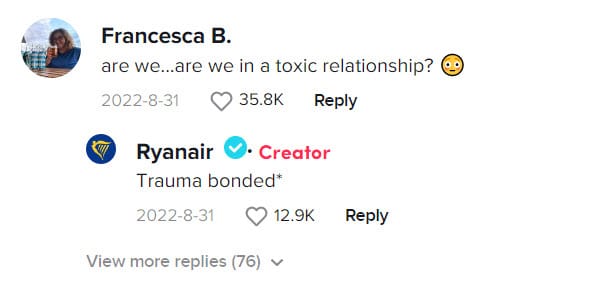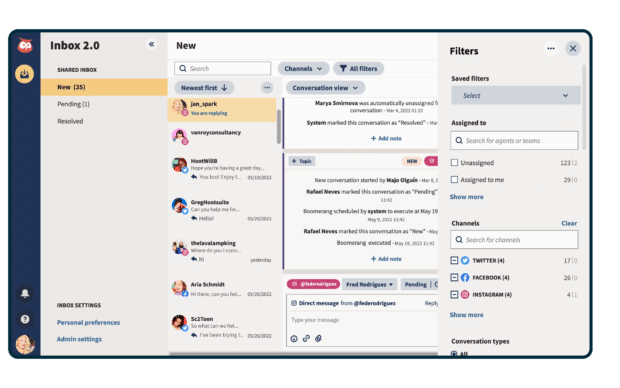Jeff Bezos is credited with saying “Your brand is what people say about you when you’re not in the room.” In the age of social media visibility and virality, what people say about you can speed its way to millions of people. Or at least be visible to your next potential customer. And that’s why social media reputation management is so important.
Reputation management isn’t about controlling the narrative. It’s about listening to what customers say, learning from their feedback, and responding in a way that builds trust in your brand.
The stakes are high. Over 2,000 executives surveyed attribute 63% of their companies’ value to their online reputations. Most consumers (93% according to this survey) say online reviews affect their buying decisions. Even hiring is affected as 86% of employees check reviews and ratings before applying for a job.
This is not a tale of woe. It’s a hero story starring you. By reading this post, you’ll have at your disposal the tools and strategies to “hear” what your customers say about your brand. You’ll be able to respond in real time. And you’ll create an online reputation that endears your company to your customers.
Bonus: Download a free guide to learn how to use social media listening to boost sales and conversions today. No tricks or boring tips—just simple, easy-to-follow instructions that really work.
Social media reputation management is the practice of observing and shaping how people perceive your brand on social media platforms like Facebook, Twitter, and TikTok.
Your organization’s online reputation is built on the references people make about your company. Each post, Tweet, TikTok, comment, or review that mentions your brand adds another brick to your reputational foundation.
Without attention and guidance, your reputation shapes itself. Maybe that’s OK if everyone interacting with your company has a great experience.
Unfortunately, people are more likely to share a negative customer experience than a positive one. And sometimes, someone will spread misleading information. So you could end up with a poor reputation on social media, even if the vast majority of your customers love you.
With a reputation management plan, you’ll know when someone calls out your brand and the mood of that mention. Plus, you’ll have a plan to address it. You can shout positive messages far and wide. And address the negative mentions before they become full-blown public relations crises.
@janellewinn @geico is the WORST PLACE TO INSURE YOUR CARS. Use anyone else but them!! #moneywasted #geico #screwgeico
A social media reputation management strategy typically consists of three components:
- An audit that surfaces your current reputation online
- Ongoing qualitative and quantitative monitoring of social channels
- Proactive and reactive messaging to build, improve, or repair customer trust
With that big-picture context in mind, let’s look at the steps you’ll take to build a loyal and loving fanbase on social media.
A good social media reputation management plan starts with listening to what people have to say about your brand. It continues with steps to mitigate negative sentiment. It includes ways to humanize your brand and promote the positive vibes your fans share.
Monitor brand mentions and conversations
Social media brand monitoring and sentiment analysis are at the heart of all online reputation management efforts.
Brand monitoring tracks all the social media posts and conversations that include a mention of your brand, products, and key spokespeople (like your CEO). Some people @ your company directly, but many don’t. So you’ll need to track branded #s and untagged mentions as well.
One thing about me, if I’m already late I’m going to Starbucks
— C Sweet🪐 (@csweetnsour) April 18, 2023
Remember to track common misspellings. If the team at Starbucks didn’t do that, they’d miss out on some interesting conversations.
Need social media monitoring tools to find these brand conversations? Hootsuite has you covered.
Sentiment analysis is the contextual review of brand mentions. It goes beyond counting how often your company is discussed on social media. It also considers the mood and opinion behind those conversations.
Say thousands of people talk about your product’s performance.
@sarahsmidwestnest Making some ✨forbidden✨ chocolate milk 🐄 #cleantok #bissellclean #littlegreenmachine #weekendvibes #teachersoftiktok
Sentiment analysis takes cues from their language to give you an idea if the mood is positive or negative.
A quantitative analysis of what you gather will tell you your social share of voice, social ROI, and your social sentiment score. From qualitative analysis, you’ll learn what hashtags and trends people associate with your brand.
Monitoring conversations about your brand online doesn’t just surface superficial sentiment. You’ll uncover all sorts of ways to improve your business — even learning how to make your product better. Which is exactly what The Isle of Paradise did here.
@theisleofparadise @foamy3 asked, we listened!💖Introducing the NEW Pro-Glow Spray Tan Mister! Shop @sephora & @Boots UK ✨#isleofparadise
A TikTok creator had plenty of nice things to say about the company’s self-tanner but didn’t love the spray applicator. The brand listened, updated the bottle, and the TikToker shared the story. That one interaction became a free focus group, advertisement, user-generated content, and customer testimonial. The company showed they were listening to customer concerns and built a lot of goodwill in the process.
Listen for competitor and keyword mentions
What happens to your competitors and throughout your industry can also affect your online reputation. Remember the viral video of security officers dragging a United Airlines customer off of an overbooked plane? Other carriers felt the heat and had to change their overbooking policies.
That’s where social listening comes in. It goes beyond looking for mentions of your brand. It also tracks conversations that include your competitors and market-related keywords.
Have a look at how gaming chair maker Mavix jumped into this thread.
If anybody’s looking for a gaming chair alternative after watching this, look no further😈
— Mavix Chairs (@mavixchairs) April 18, 2023
Someone tweeted an unflattering video of their competitor. Mavix’s soft-touch trolling gathered interest and good feelings from gamers who needed a new seat. It’s a situation made possible first by active social media listening.
You should also set your software to listen for important keywords like H&R Block did here.
🧮 It’s Tax Day in the USA! I’m counting beans 🫘 and filling out tax forms! 📝 https://t.co/XK6juft8p6 #taxday #fileyourtaxes #CPA #taxaccountant #beancounter 🫘🧮 #roughday #roughcollie #collie pic.twitter.com/xL9EdmYDYY
— Collie Crusader (@CollieCrusader) April 18, 2023
They found an opportunity to join an ongoing conversation. Even though it didn’t mention their company. And got to Tweet about an adorable pup doing taxes.
Engage and respond quickly
It’s not enough to listen to social media chatter about your brand. You must also respond, and do it fast. Why? 75% of U.S. consumers expect brands to reply to social media questions and complaints within a day. 20% think the response should be immediate!
Every mention is an opportunity to increase engagement on social media and build trust for your brand. Some conversations will be fun and friendly. Others may start because your customer is frustrated or confused. Social media listening tools will help you find and reply to these conversations fast. Now, let’s look at how you can respond to the full range of social media interactions.
For starters, you can turn your social media account into a public-facing customer service center. That’ll help ease customers’ confusion. Many people turn to social media when they need help, so it’s a natural place to answer questions and give guidance.
Nike, for example, has a dedicated Twitter account it uses to solve its customers’ dilemmas.
Any update on this? I am still having this issue…
— J. Strand (@DJ_Ajaxx) September 15, 2022
Nike doesn’t only use @nikeservice to answer individual questions, though. The brand also posts general updates that act like an ongoing FAQ section. Followers can find solutions before they even have to ask a question. Which means less burden on their customer service reps.
Sometimes, people talk about your brand in amusing and positive ways. Those are great opportunities to drop in and join the conversation. Wendy’s rarely misses a chance to talk square burgers or…historical architecture?
Why the sunrooms, Wendy. Spit some history my way!
— jaxsaid 🐌 (@jaxsaid) April 18, 2023
Not all social media posts are going to be positive, though. When a customer does share their disappointment, it’s important to help them quickly.
I’m not sure why @dominos has had me on hold for this long or why my food is still in “prep” an hour later but okay
— liv (@oliviafyeager) April 25, 2023
No matter which type of conversation you encounter, the key is to remember that there’s a person on the other end. Think about what you’d say to them if they were standing in front of you. Use that to help make your responses more human.

Manage all your messages stress-free with easy routing, saved replies, and friendly chatbots. Try Hootsuite’s Inbox today.
Book a DemoEnable and respond to reviews
When nurtured and managed, online reviews are a great type of grassroots, word-of-mouth marketing. They’re also an important part of cultivating your social media presence. A Brightlocal survey found that nearly half of consumers look at Facebook reviews.
The same survey also revealed that buyers think it’s important for brands to have at least a four-star rating. And more than half of buyers say they want to see both positive and negative reviews from the last two to four weeks.
You’ll need a steady stream of positive reviews. To get them, make sure you’ve turned on Facebook recommendations. Then don’t be afraid to ask. Over 50% of shoppers are “likely” or “highly likely” to leave a review if the business asks them to. And what’s the most effective way to request a customer review? It’s a pretty close race between email, in-person, on a receipt, and through social media, according to the survey.
Gathering a bunch of recent 5-star reviews is great. But if you really want to wow customers, reply to your reviews. 88% of consumers said they’re “likely to use a business if they can see the business owner responds to all reviews, whether positive or negative.”
When you do receive a bad review, you’ve got to tackle it head-on. It’s a signal to all customers that you’re willing to solve whatever issue may come up.
A good rule of thumb is to address bad reviews publicly. But then solve them privately. Those conversations may contain private information. That’s especially important if you work in a regulated industry like healthcare.
But don’t be shy about sharing the wins, either. You’ve worked hard to deliver a product or service people love. Use their hard-won feedback to earn more business by placing it on social posts or your website.
Cultivate your reputation proactively
You don’t need to wait for a customer to post about you. There are ways to establish and manage your social media reputation proactively.
One option is to publish content on your channels that shows the world what your brand is all about. Take the Irish leader of low-cost air travel, for example. The company is infamous for cut-rate services, but one look at its TikTok account and it’s clear that Ryanair just doesn’t care.
@ryanair Welcome back to the party 😈 #ryanair
Ryanair doesn’t stop there. Its social team has masterfully spun its bad reputation into a Stockholm Syndrome-like relationship with the very people that malign them online.
Source: Ryanair’s TikTok
The tricky balance of snark and savagery is just the ticket for RyanAir. Its customers know full well they’re not getting a luxury ride, so any complaints about service can be met with a “see, we told you” attitude.
GoPro looks at social media reputation through a different lens. They don’t tell shoppers what their brand is. They ask current users to show it.
GoPro gathers UGC (user-generated content) by asking customers to tag images and video posts with a hashtag like #gopro. Consumers trust authentically created UGC over other types of content. So this strategy generates a lot of confidence in the GoPro brand.
Set up (and enforce) brand guidelines
No matter if your brand is snarky, serious, or somewhere in between, consistency is the key to maintaining your reputation online. A rogue employee posting off-brand replies can damage your reputation in no time.
Source: Facebook
In this case, it’s a fake “customer support” Facebook account trolling people. But you want to avoid a situation where your employees respond in a way that hurts your reputation. So you’ll need to create both a social media style guide and a social media policy.
The social media policy outlines big-picture expectations for how your employees post and engage on branded social media channels (or when they’re posting on personal accounts on behalf of your brand). The policy covers content types, how to respond to positive and negative feedback, legal compliance, and more. Here’s a guide to help you write your social media policy (it includes a free template to help you get started).
A social media style guide answers questions about how you’ll craft individual posts. What tone will you take on Twitter, LinkedIn, and Facebook? Are there buzzwords and jargon you want to use (or stay away from)? And, of course, are emojis part of the plan?
Need more? This in-depth post will show you everything your social media style guide needs to have.
Social media reputation management software
Social media is a big place. It’s impossible to surface all the relevant conversations you should be a part of. These tools will help you find, analyze, and reply to mentions that matter to your business.
Hootsuite
Hootsuite makes it easy to track and respond to brand, competitor, and keyword mentions across all your social media accounts.
The secret is Hootsuite Streams, a versatile way to view a variety of social media activities in one convenient space. You can create a stream to monitor keywords, brand or competitor mentions, and hashtags.
Once your streams are up and running, you can jump into important conversations by replying from your dashboard. So when someone shares your latest Tweet or talks about your great service, you can reply quickly without opening multiple platforms.
Hootsuite also comes with Inbox, an all-in-one communication tool for social media that helps you keep tabs on all your DMs and comments in one place (and address sensitive issues in a timely manner, before they become a threat to your reputation). This includes:
- Private messages and DMs
- Public messages and posts on your profiles
- Dark and organic comments
- Mentions
- Emoji reactions
… and more.
The all-in-one agent workspace makes it easy to
- Track the history of any individual’s interactions with your brand on social media (across your accounts and platforms), giving your team the context needed to personalize replies
- Add notes to customers’ profiles (Inbox integrates with Salesforce and Microsoft Dynamics)
- Handle messages as a team, with intuitive message queues, task assignments, statuses, and filters
- Track response times and CSAT metrics
Plus, Inbox comes with handy automations:
- Automated message routing
- Auto-responses and saved replies
- Automatically triggered customer satisfaction surveys
- AI-powered chatbot features
Brandwatch
Brandwatch is a social listening platform that searches through billions of social media interactions. It delivers insightful data about your brand’s reputation.
With Brandwatch, you learn what words are most commonly associated with your brand. You also know how often people talk about your company. And then you see the sentiment behind all those conversations.
Brandwatch is fully integrated with Hootsuite. You can view and respond to big-picture trends and individual instances from one place.
ReviewTrackers
ReviewTrackers rounds out your social media reputation management toolbox by giving you a convenient space to see and engage with your online reviews.
Source: ReviewTrackers
If you use the ReviewTrackers plugin on Hootsuite, you can arrange your reviews into streams the same way you do social media mentions and posts. And also, like other streams, you can respond to your reviews in real time without leaving the platform. Then when those 5-star raves start rolling in, just hop over to your Hootsuite Creator workspace and share them across all your social channels.
Save time managing your social media presence with Hootsuite. From a single dashboard, you can publish and schedule posts, find relevant conversions, engage the audience, measure results, and more. Try it free today.
Manage all your social media in one place, measure ROI, and save time with Hootsuite.
Book a Demo






![Screenshot of a Hootsuite streams dashboard featuring reviews from the ReviewTrackers integration]](https://blog.hootsuite.com/wp-content/uploads/2023/05/The-2023-Guide-to-Social-Media-Reputation-Management-5-620x297.png)




